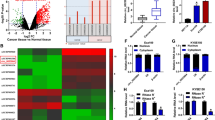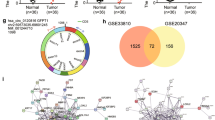Abstract
Background
Currently, multiple circular RNAs (circRNAs) have been verified to act as essential regulators in the progression of esophageal squamous cell carcinoma (ESCC). However, there is no study regarding the role of circGFPT1 in the progression of cancers including ESCC. We aimed to investigate the role of circGFPT1 in ESCC progression.
Methods
Quantitative real-time polymerase chain reaction (qRT-PCR) was utilized to measure the expression of circGFPT1, miR-142-5p and HS1-associated protein X-1 (HAX1). 3-(4,5-Dimethyl-2-thiazolyl)-2,5-diphenyl-2-H-tetrazolium bromide (MTT) and 5-ethynyl-2′-deoxyuridine (EdU) assays were employed to evaluate cell proliferation. Cell migration and invasion were detected by wound-healing and transwell assays. Flow cytometry analysis was conducted to assess cell apoptosis. The protein expression of E-cadherin, N-cadherin, Vimentin, C-caspase3, HAX1 and nuclear proliferation marker (Ki67) was analyzed by western blot or immunohistochemistry assay.
Results
CircGFPT1 was up-regulated in ESCC tissues and cells. Silencing of circGFPT1 repressed cell proliferation and induced cell apoptosis in ESCC cells. CircGFPT1 acted as a sponge of miR-142-5p. The effects of circGFPT1 knockdown on ESCC cell proliferation and apoptosis were reversed by miR-142-5p inhibition. HAX1 was confirmed to be a target gene of miR-142-5p. CircGFPT1 knockdown inhibited HAX1 expression by targeting miR-142-5p. Additionally, circGFPT1 knockdown hampered tumorigenesis in vivo.
Conclusion
CircGFPT1 promoted ESCC cell growth and repressed apoptosis by up-regulating HAX1 through sponging miR-142-5p.









Similar content being viewed by others
References
Murphy G, McCormack V, Abedi-Ardekani B, Arnold M, Camargo MC, Dar NA, et al. International cancer seminars: a focus on esophageal squamous cell carcinoma. Ann Oncol. 2017;28:2086–93.
Abnet CC, Arnold M, Wei WQ. Epidemiology of esophageal squamous cell carcinoma. Gastroenterology. 2018;154:360–73.
Reichenbach ZW, Murray MG, Saxena R, Farkas D, Karassik EG, Klochkova A, et al. Clinical and translational advances in esophageal squamous cell carcinoma. Adv Cancer Res. 2019;144:95–135.
Li C, Tian Y, Liang Y, Li Q. Circ_0008035 contributes to cell proliferation and inhibits apoptosis and ferroptosis in gastric cancer via miR-599/EIF4A1 axis. Cancer Cell Int. 2020;20:84.
Chen LL, Yang L. Regulation of circRNA biogenesis. RNA Biol. 2015;12:381–8.
Zhong Z, Lv M, Chen J. Screening differential circular RNA expression profiles reveals the regulatory role of circTCF25-miR-103a-3p/miR-107-CDK6 pathway in bladder carcinoma. Sci Rep. 2016;6:30919.
Hansen TB, Jensen TI, Clausen BH, Bramsen JB, Finsen B, Damgaard CK, et al. Natural RNA circles function as efficient microRNA sponges. Nature. 2013;495:384–8.
Ahmed I, Karedath T, Andrews SS, Al-Azwani IK, Mohamoud YA, Querleu D, et al. Altered expression pattern of circular RNAs in primary and metastatic sites of epithelial ovarian carcinoma. Oncotarget. 2016;7:36366–81.
Zhang Z, Li X, Xiong F, Ren Z, Han Y. Hsa_circ_0012563 promotes migration and invasion of esophageal squamous cell carcinoma by regulating XRCC1/EMT pathway. J Clin Lab Anal. 2020;34:e23308.
Zhang C, Lian H, Xie L, Yin N, Cui Y. LncRNA ELFN1-AS1 promotes esophageal cancer progression by up-regulating GFPT1 via sponging miR-183-3p. Biol Chem. 2020;401:1053–61.
Yang C, Peng P, Li L, Shao M, Zhao J, Wang L, et al. High expression of GFAT1 predicts poor prognosis in patients with pancreatic cancer. Sci Rep. 2016;6:39044.
Li D, Guan M, Cao X, Zha ZQ, Zhang P, Xiang H, et al. GFPT1 promotes the proliferation of cervical cancer via regulating the ubiquitination and degradation of PTEN. Carcinogenesis. 2022;43:969–79.
Hu X, Wu D, He X, Zhao H, He Z, Lin J, et al. circGSK3β promotes metastasis in esophageal squamous cell carcinoma by augmenting β-catenin signaling. Mol Cancer. 2019;18:160.
Acunzo M, Romano G, Wernicke D, Croce CM. MicroRNA and cancer—a brief overview. Adv Biol Regul. 2015;57:1–9.
Xiao C, Nemazee D, Gonzalez-Martin A. MicroRNA control of B cell tolerance, autoimmunity and cancer. Semin Cancer Biol. 2020;64:102–7.
Labbe M, Hoey C, Ray J, Potiron V, Supiot S, Liu SK, et al. microRNAs identified in prostate cancer: Correlative studies on response to ionizing radiation. Mol Cancer. 2020;19:63.
Yu J, Chen S, Niu Y, Liu M, Zhang J, Yang Z, et al. Functional significance and therapeutic potential of miRNA-20b-5p in esophageal squamous cell carcinoma. Mol Ther Nucl Acids. 2020;21:315–31.
Wang Z, Liu Z, Fang X, Yang H. MiR-142-5p suppresses tumorigenesis by targeting PIK3CA in non-small cell lung cancer. Cell Physiol Biochem. 2017;43:2505–15.
Yao R, Xu L, Wei B, Qian Z, Wang J, Hui H, et al. miR-142-5p regulates pancreatic cancer cell proliferation and apoptosis by regulation of RAP1A. Pathol Res Pract. 2019;215:152416.
Yan J, Yang B, Lin S, Xing R, Lu Y. Downregulation of miR-142-5p promotes tumor metastasis through directly regulating CYR61 expression in gastric cancer. Gastric Cancer. 2019;22:302–13.
Li X, Chen W, Jin Y, Xue R, Su J, Mu Z, et al. miR-142-5p enhances cisplatin-induced apoptosis in ovarian cancer cells by targeting multiple anti-apoptotic genes. Biochem Pharmacol. 2019;161:98–112.
Xiao S, Liu N, Yang X, Ji G, Li M. Polygalacin D suppresses esophageal squamous cell carcinoma growth and metastasis through regulating miR-142-5p/Nrf2 axis. Free Radic Biol Med. 2021;164:58–75.
Liang Z, Zhong Y, Meng L, Chen Y, Liu Y, Wu A, et al. HAX1 enhances the survival and metastasis of non-small cell lung cancer through the AKT/mTOR and MDM2/p53 signaling pathway. Thorac Cancer. 2020;11:3155–67.
Yan J, Ma C, Cheng J, Li Z, Liu C. HAX-1 inhibits apoptosis in prostate cancer through the suppression of caspase-9 activation. Oncol Rep. 2015;34:2776–81.
Luo X, Li Z, Li X, Wang G, Liu W, Dong S, et al. hSav1 interacts with HAX1 and attenuates its anti-apoptotic effects in MCF-7 breast cancer cells. Int J Mol Med. 2011;28:349–55.
Huang D-W, Huang M, Lin X-S, Huang Q. CD155 expression and its correlation with clinicopathologic characteristics, angiogenesis, and prognosis in human cholangiocarcinoma. Onco Targets Ther. 2017;10:3817–25.
Chen BJ, Byrne FL, Takenaka K, Modesitt SC, Olzomer EM, Mills JD, et al. Analysis of the circular RNA transcriptome in endometrial cancer. Oncotarget. 2018;9:5786–96.
Zhang M, Huang N, Yang X, Luo J, Yan S, Xiao F, et al. A novel protein encoded by the circular form of the SHPRH gene suppresses glioma tumorigenesis. Oncogene. 2018;37:1805–14.
Verduci L, Strano S, Yarden Y, Blandino G. The circRNA-microRNA code: emerging implications for cancer diagnosis and treatment. Mol Oncol. 2019;13:669–80.
Yu C, Li S, Hu X. Circ_0005576 promotes malignant progression through miR-874/CDK8 axis in colorectal cancer. Onco Targets Ther. 2020;13:7793–805.
Zheng Q, Bao C, Guo W, Li S, Chen J, Chen B, et al. Circular RNA profiling reveals an abundant circHIPK3 that regulates cell growth by sponging multiple miRNAs. Nat Commun. 2016;7:11215.
Zhu J, Zhou L, Wei B, Qian Z, Wang J, Hui H, et al. miR1425p inhibits pancreatic cancer cell migration and invasion by targeting PIK3CA. Mol Med Rep. 2020;22:2085–92.
Liu J, Jiang X, Zou A, Mai Z, Huang Z, Sun L, et al. circIGHG-induced epithelial-to-mesenchymal transition promotes oral squamous cell carcinoma progression via miR-142-5p/IGF2BP3 signaling. Cancer Res. 2021;81:344–55.
Zhang Q, Liu H, Zhang J, Shan L, Yibureyimu B, Nurlan A, et al. MiR-142-5p suppresses lung cancer cell metastasis by targeting yin yang 1 to regulate epithelial-mesenchymal transition. Cell Reprogram. 2020;22:328–36.
Zha Z, Li J. MicroRNA125a5p regulates liver cancer cell growth, migration and invasion and EMT by targeting HAX1. Int J Mol Med. 2020;46:1849–61.
Li R, Zheng JZ, Huang X. Suppression of HAX-1 induced by miR-325 resensitizes bladder cancer cells to cisplatin-induced apoptosis. Eur Rev Med Pharmacol Sci. 2020;24:9303–14.
Li M, Tang Y, Zang W, Xuan X, Wang N, Ma Y, et al. Analysis of HAX-1 gene expression in esophageal squamous cell carcinoma. Diagn Pathol. 2013;8:47.
Li F, Shang Y, Shi F, Zhang L, Yan J, Sun Q, et al. Expression of integrin β6 and HAX-1 correlates with aggressive features and poor prognosis in esophageal squamous cell carcinoma. Cancer Manag Res. 2020;12:9599–608.
Yu Z, Ni F, Chen Y, Zhang J, Cai J, Shi W. miR-125b suppresses cell proliferation and metastasis by targeting HAX-1 in esophageal squamous cell carcinoma. Pathol Res Pract. 2020;216:152792.
Funding
This work was supported by A controlled study of a standardized treatment plan for myasthenia gravis with minimally invasive expanded thymectomy (S2017—ZDYF—ZDXM—SF—0226).
Author information
Authors and Affiliations
Corresponding author
Ethics declarations
Conflict of interest
The authors declare that they have no conflict of interest.
Additional information
Publisher's Note
Springer Nature remains neutral with regard to jurisdictional claims in published maps and institutional affiliations.
Supplementary Information
Below is the link to the electronic supplementary material.
Fig. S1
: The influences of miR-142-5p silencing on ESCC cell proliferation and apoptosis. A–D ECA-109 and KYSE-150 cells were transfected with anti-miR-NC or anti-miR-142-5p, and then cell proliferation was analyzed by EdU assay (A), cell migratory and invasive abilities by wound-healing and transwell assays (B, C), and cell apoptosis by flow cytometry analysis (D). **P<0.01, ***P < 0.001. (TIF 269 kb)
Rights and permissions
Springer Nature or its licensor (e.g. a society or other partner) holds exclusive rights to this article under a publishing agreement with the author(s) or other rightsholder(s); author self-archiving of the accepted manuscript version of this article is solely governed by the terms of such publishing agreement and applicable law.
About this article
Cite this article
Feng, Z., Zhang, T., Cheng, S. et al. CircGFPT1 regulates the growth and apoptosis of esophageal squamous cell carcinoma through miR-142-5p/HAX1 axis. Gen Thorac Cardiovasc Surg 72, 41–54 (2024). https://doi.org/10.1007/s11748-023-01955-2
Received:
Accepted:
Published:
Issue Date:
DOI: https://doi.org/10.1007/s11748-023-01955-2




